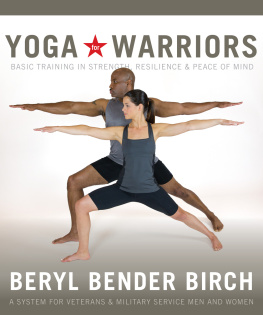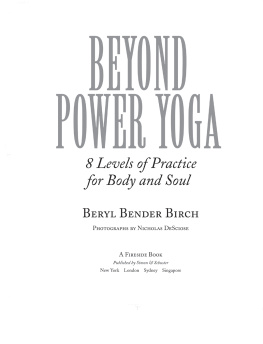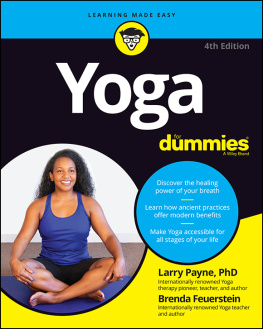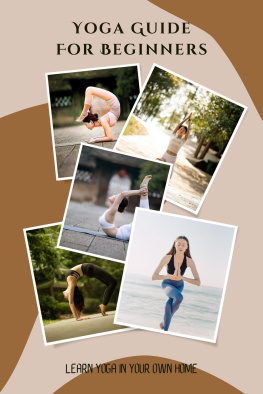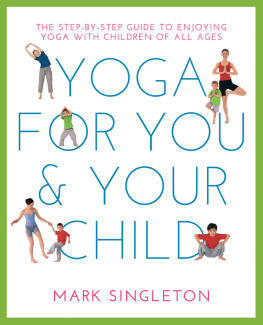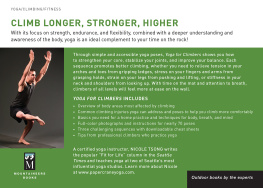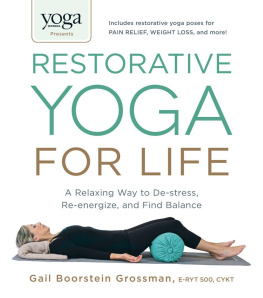
FIGURES
PREFACE
This is a book about a yoga practiceyour yoga practice. It was written primarily for you: military service membersmen and womenveterans, warriors, soldiers, sailors, airmen, coast guardsmen, and marines, both active and reserve members of the National Guard and the Reserves, as well as for government workers, contractors, journalists, and anyone deployed to a war zone. I have never been in the military. I have very little idea of what it feels like, as Charles Hoge writes in Once a Warrior, Always a Warrior, to live with danger, convoy in dangerous sectors, be shot at, travel outside the wire, or to live with the constant threat of attack. But I do know what it feels like to do yoga in all its formsmovement, breathing, and meditation. I have been practicing yoga, daily, since l971, teaching yoga to athletes since l974, and using yoga practices to help first responders and those with post-traumatic stress (PTS) since 2001.
I was living in New York City at the time of 9/11. Two days after the tragedy, my friend JoAnn Difede, director of the Program for Anxiety and Trauma Stress Studies (PATSS)called to see if I might be available to help the families of burn victims who escaped from the towers. JoAnn wanted someone with extensive professional experience in yoga to assist the people who were flooding her offices.
As an expert in post-traumatic stress disorder (PTSD), as itthen a very little known conditionwas called at the time, JoAnn was at the center of enormous demand to treat the firemen, policemen, city workers, government workers, Con Edison employees, employees of the corporations that had been affected (like Marsh & McClennan and Cantor Fitzgerald), National Guardsmen, and families of those who had perished or were missingas well as anyone who had escaped from downtown or was working in the post-attack rubble and cacophony. The media called her nonstop for quotes about what people were feeling, network news stations called for interviews, hospitals around the county called looking for advice on treating traumatized Americans. Unexpectedly, JoAnn was the go-to person for expert advice on PTSD.
When I phoned her back, it took awhile to get through. When she finally answered, her voice was rushed as she described what she was facing in her office.
Isnt there something you could do, she asked., just to help them sleep or have a moment of relief from their overwhelming grief? Have them breathe or meditate or something? When can you come? Now?
When I walked into a small room in the hospital burn center, I was nervous. It was filled with comfortable couches and chairs, a plain wooden table, and just a few men and womenrelatives of the people who were wrapped in bandages from head to toe and heavily medicated for relief from unbelievable pain. Many were dying, others struggling for life. Their family members sat in stunned silence.
They all looked up as I came into the room, hoping for news of someone, somewhere. They looked exhausted. No one had slept since the towers collapsed. I didnt assume anything. I didnt assume I could help. I didnt assume I knew anything that could be of use. Faced with such incredible suffering, how could anyone go on with the mundane activities of life? There was such a sense of despair in the room. I just sat down quietly at the table and put my head in my hands.
Dear Lord, I thought, give me strength and the right words to say. A man came over and put his hand on my shoulder. We both started to cry. That was itthe icebreaker.
I introduced myself and suggested that we, all together, see if there was something we could discover, something we could do, that would help us all to sleep, to deal with the tragedy, to grieve while avoiding despair and depression. I remembered what I had done in yoga classes the night before: sitting with everyone and breathing. It was the breathing that seemed to offer the most relief and the most comfort.
Lets just sit together, I suggested. Everyone moved into a circle around the table, and I invited them to close their eyes. What happened after that, I dont remember very well, except that I slowly came around to teaching them a closed-mouth yoga breathing technique called ujjayi. Breathe in, breathe outwith sound. Thats all. You just pay attention to the sound and see if you can make the inhalation and the exhalation the same length and make them sound as much alike as possible.
Within minutes, everyone at the table was making the slow, controlled, aspirant sound of the inhalation and the deep, sibilant sound of the exhalation. They just got it. They hung on it as a lifeline. Time became timeless. We sat like that for nearly thirty or forty minutes, although none of us had a clue how long we had been there. I kept an eye on them. Each of them just climbed into the breath and went to a place that was quiet and peacefulfor a moment. One man fell asleep during the session; God bless him. It was joyful to see him sleeping. Another woman actually smiled and came and hugged me. I cant say it was some miraculous cure for suffering, but it did help.
I said to the group, I hope you will remember that well enough to use in your most difficult moments; it will help you to sleep and to find strength.
The man who had been sleeping looked up and asked, Can you come back tomorrow? So I did.
In the long run, the program developed at the burn center was so well received that it became a model for using yoga therapy to manage pain and stress and help with post-traumatic stress. JoAnns staff of psychologists learned the breathing technique and, in turn, taught it to their patients. Months later, the PATSS received a grant from the Greater New York Hospital Association that funded a program for yoga classes and training in ujjayi breathing for hospital employees. I initially taught the course, and then passed it on to a number of teachers whom I had trained. The program is still growing and bringing much-needed stress relief to employees at Weill Cornell Medical Center.
Thanks to JoAnns urgent call for help after 9/11, I became one of the first yoga professionals to apply yoga methodology to the integral treatment of post-traumatic stress. As I look back over my twenty-two years of teaching in New York Citywith tens of thousands of students in my classes over that timeIm sure that, unbeknownst to me, many were veterans, and no doubt many were helped by the postures, the breathing, and the meditation techniques we taught.
But it wasnt until after 9/11 that the medical community began to realize just how helpful the broad spectrum of mindful yoga therapies could be for anxiety disorders and post-traumatic stress, when intentionally integrated into more traditional medical forms of treatment such as cognitive behavioral therapy, virtual reality therapy, or eye movement desensitization reintegration (EMDR).
This realization has since spread, and yoga and its mind-body practices are now viable medical treatment alternatives and support systems. Today, extensive research is being conductedsome of it even funded by the Department of Defense (DOD) and the Department of Veterans Affairs (VA)that shows how conscious breathing, mindfulness meditation, a practice called yoga nidra (or yoga sleep), and the practice of the yoga postures are allin the case of the DOD studyhelping veterans heal and recover from debilitating mental and physical injury.
Thanks to research at places like Harvard University, the Preventive Medicine Research Institute, the Arizona Center for Integrative Medicine, the UMass Memorial Medical Center, the UCLA Mindful Awareness Research Center, and many other prestigious institutions, yoga and meditation now have scientific support as a means for reducing stress, improving attention, boosting the immune system, and promoting a general sense of health and psychological well-being. The scientific community is finally confirming what yogis have known for thousands of years: the mind can heal the body and itself.
Next page
